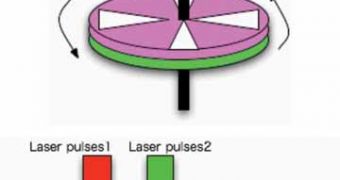The new invention, which harnesses the power of light to convert it into mechanical energy, was designed and demonstrated by a team of Japanese researchers, who have proven that they could provide solutions to the mechanical controls that cannot use electric motors. The prototype was built by the Japanese physicist Hideki Okamura, from the International Christian University in Tokyo.
The device is fueled by light, with the help of laser tweezers, which use the principle of optical tweezers. These create forces of attraction or repulsion of a few piconewtons on dielectric objects, by shining them with a focused beam of laser. However, though inspired by the optical tweezers principle, Okamura, chose to try a new technique that uses only simple lasers. The device converts the light from the laser into mechanical power, but, so far, it presents a relative inefficiency and cannot be used in reverse gears; nevertheless it can have new applications in multiple areas.
The basic principle for making the motor to turn is to use a copper disk, with a hole in the center, which also represents the whole motor, and shine it with a laser, in this case a laser that creates light in the 532 nanometer domain associated with the color green. The action of the laser light on the surface of the disk causes it to heat up and expand, fact that will produce in effect a fast-moving wave on the surface of the disk.
When it is placed on a axle and the disk touches the surface of another body, the motion of the fast-moving wave is transferred to create movement between the two surfaces that will be converted into rotational movement.
The use of laser tweezers involves the fact that the photons emitted by the laser will exert pressure of a dielectric object, with the help of the physical momentum, and has an efficiency of only 0.000000001 percent; while an engine 100.000 times more effective can be built by using the technique used by Okamura, to partially transfer power from the laser to the copper disk.
Though researches in this domain are quite advanced, and the power of the laser was previously used to create devices that bend when subjected to it, nobody has ever succeeded in turning the laser light's power into rotational movement.
Okamura believes that the problem regarding the inability of using the motor into reverse could be solved by using a special material that would spin in different directions, when shined with laser light of different frequencies.
This type of motor could be extremely useful in environments with strong magnetic field, because these do not use the magnetic effects to spin and are not affected by the electromagnetism used in scientific instruments or in MRI scanners.
The motor is, so far, converting light into mechanical energy in inefficient ways; nevertheless, it can be accurately controlled with the help of very short laser pulses.

 14 DAY TRIAL //
14 DAY TRIAL //